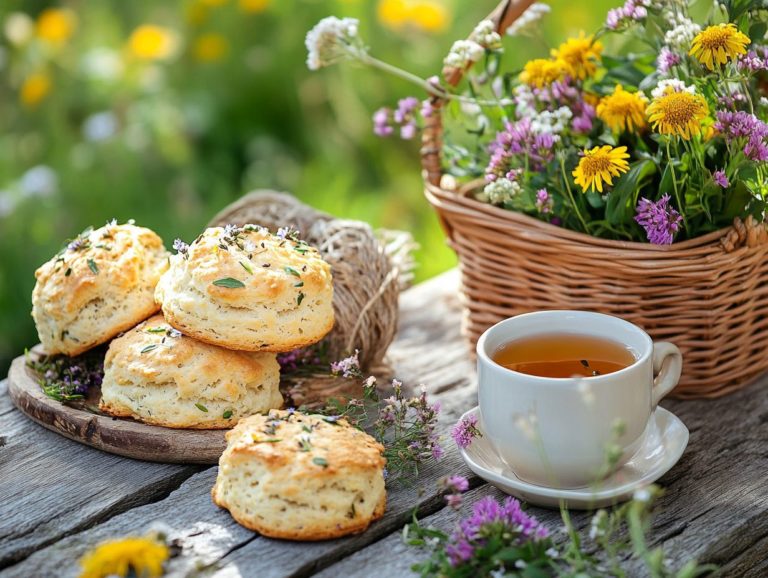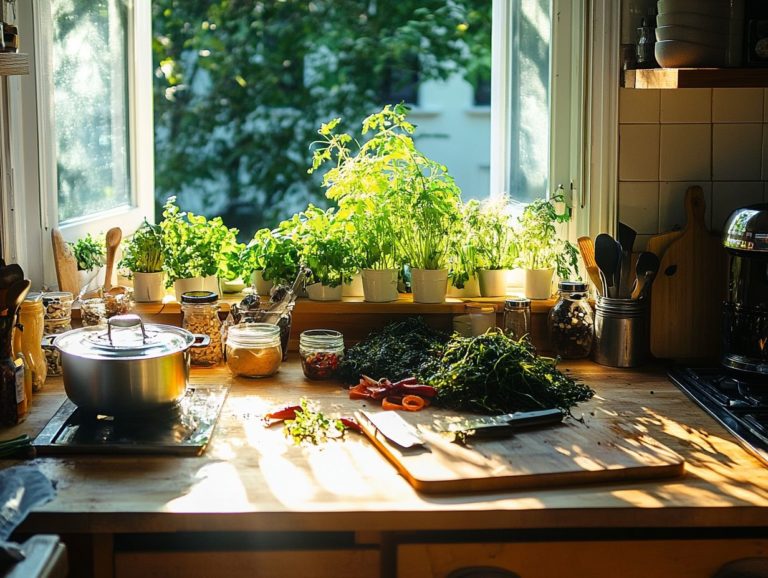Using Wild Edibles for Creative Sauces
Exploring the realm of wild edibles unveils a treasure trove of flavors and nutritional benefits that can elevate your cooking experiences.
From vibrant greens to fragrant herbs, these naturally occurring ingredients present unique tastes and essential nutrients that can enhance any meal. This article will guide you in identifying and safely harvesting these wild gems. You’ll find creative recipes to incorporate them into delicious sauces and insights on how to pair them with your favorite dishes.
This article will outline important considerations to ensure your foraging experience is both enjoyable and safe. Get ready to dive into the wonders of nature s pantry!
Contents
Key Takeaways:

- Adding wild edibles to sauces introduces unique flavors and boosts nutritional value.
- Safe and sustainable foraging practices are vital when identifying and harvesting wild edibles.
- Pairing various wild edibles with different foods enhances the overall taste and experience of a dish.
The Benefits of Using Wild Edibles
Embracing wild edibles presents a remarkable array of benefits. These nutrient-dense plants and mushrooms, often thriving in North America’s diverse ecosystems, are packed with vitamins and minerals that can enhance your well-being.
By incorporating wild edibles into your lifestyle, you prioritize your health and engage with your community through foraging activities. This connection to nature fosters relationships with others and deepens your appreciation for the rich tapestry of flora and fauna that surrounds you.
Nutritional Value and Flavor Profile
The nutritional value of wild edibles is truly remarkable. Many of these plants, like dandelion, nettle, and garlic mustard, boast vitamins, minerals, and antioxidants that often outshine those found in conventional vegetables.
These vibrant greens introduce unique flavors imagine the peppery kick of garlic mustard or the earthy richness of nettle. Identifying these plants can be an exhilarating adventure; you can easily spot dandelion leaves with their jagged edges and cheerful yellow flowers.
Incorporating these wild edibles into your recipes is simple. Toss dandelion leaves into a fresh salad for a zesty bite, steam nettle for a nutritious soup, or use garlic mustard as a flavorful addition to pestos. Each wild find opens up a world of culinary possibilities, inviting you to unleash your creativity in the kitchen.
Identifying and Harvesting Wild Edibles
Identifying and foraging for wild edibles requires care and expertise. In North America, numerous plants are safe to eat and play a vital role in sustainable foraging practices that safeguard our ecosystems.
It’s essential to learn how to distinguish between edible species and their invasive counterparts to ensure responsible harvesting. Your knowledge can make a significant difference in preserving nature while enjoying the bounty it provides.
Ready to try foraging? Explore more tips on wild edibles and discover the joy of gathering your own ingredients!
Safe and Sustainable Foraging Practices

Adopting safe and sustainable foraging practices is essential for anyone eager to gather wild edibles. Not only does this approach preserve the natural environment, but it also safeguards your health and well-being while fostering a deeper connection with both the community and nature. Always consider tips for safe foraging, especially in North America.
To embark on this rewarding journey, familiarize yourself with local plant species. It s crucial to study identification guides or apps that offer detailed photos and descriptions. Keeping a keen eye is vital, especially when avoiding poisonous plants, as many edible varieties have toxic look-alikes. Respecting local regulations, including seasonal restrictions and protected species, is imperative for maintaining ecological balance.
Take advantage of community resources such as local workshops, online forums, and foraging clubs. These platforms provide valuable knowledge and hands-on experiences that give you the power to forage responsibly and sustainably.
Creative Ways to Use Wild Edibles in Sauces
Exploring creative uses of wild edibles in your sauces can truly elevate your cooking endeavors. These unique ingredients not only highlight seasonal flavors but also pack in beneficial nutrients. If you’re looking for more ideas, check out what you can make with foraged edibles, and you might also consider making preserves or pickles with your finds.
Imagine incorporating garlic mustard or Japanese knotweed into your traditional sauces; they add robust flavors and provide a delightful sense of adventure to your dishes.
Incorporating Different Types of Wild Edibles
Incorporating various types of wild edibles into your meals not only enriches your diet but also allows you to celebrate the unique seasonal flavors that nature generously provides throughout the year from wild greens to mushrooms, berries, nuts, and starches.
By foraging for ingredients like dandelion greens, which add a delightful peppery kick to salads, or introducing the delicate essence of chickweed into a refreshing summer soup, you can elevate your culinary creations with remarkable ease.
Picture yourself crafting a luscious berry compote with freshly picked blackberries or blueberries to crown a simple dessert, blending sweet and tart notes that truly resonate with the season.
For an extraordinary twist, consider folding saut ed wild mushrooms, such as chanterelles, into a creamy risotto, resulting in a delightful rich savory flavor that will tantalize your palate.
With a wealth of possibilities at your fingertips, incorporating wild edibles into your everyday meals invites not only culinary creativity but also a profound connection to the environment around you.
Recipes and Inspiration
Look for recipes with wild edibles to spark your culinary ideas and invite you to experiment with unique ingredients, like dandelion in salads or nettle in soups. This journey also opens the door to delightful preserves and pickles that elevate your kitchen repertoire. Consider including recipes foraged from your local environment.
By integrating these often-overlooked plants into your everyday meals, you can experience a rich tapestry of flavors that transforms ordinary dishes into something extraordinary. Imagine infusing a traditional pasta with vibrant wild garlic or incorporating foraged mushrooms into a creamy risotto each bite becomes an adventure into nature’s bounty.
Being creative in the kitchen helps you appreciate seasonal ingredients and inspires a sense of adventure in your cooking. Delving into these ingredients offers you the chance to step outside your culinary comfort zone, leading to a dining experience that is not just satisfying but truly memorable.
Pairing Wild Edibles with Different Foods

Imagine the possibilities when you pair wild edibles with various foods to craft harmonious dishes that elevate your culinary experience. By bringing together the unique flavors of nature with complementary ingredients, you create delightful outcomes that tantalize the palate and celebrate the beauty of foraged ingredients, enriching your meals with the essence of nature.
Get out there and start foraging today! Share your wild culinary adventures with us!
Complementary Flavors and Dishes
Understanding complementary flavors is vital for using wild edibles in your dishes. Foods like blackberries and autumn olive can enhance both sweet and savory creations, providing balance and depth.
Add herbs and nuts to take your dishes to the next level!
Picture this: a savory tart that perfectly marries tangy goat cheese with the sweet, tart notes of foraged blackberries. This creates an exquisite dance on your palate. Now, consider an autumn olive sauce. This could effortlessly elevate a traditional duck confit, with its naturally sweet yet slightly acidic profile cutting through the richness of the meat.
By understanding how different flavors work together how bitter, sweet, sour, and umami interact you can unlock new dimensions in your favorite recipes. Infuse them with both nostalgia and a sense of adventure. These wild ingredients not only bring nutritional benefits but also spark creativity and exploration in your kitchen. You ll create unforgettable dining experiences!
Considerations for Using Wild Edibles
Start incorporating wild edibles into your cooking now for an exciting culinary adventure! Be mindful of potential allergies and the risks that come with unfamiliar plants. Understanding proper preparation techniques ensures your safety as it enhances your culinary experience.
Learn to savor the unique flavors these ingredients offer while also addressing any adverse reactions you may encounter.
Allergies and Potential Risks
Understanding allergies and potential risks associated with wild edibles is essential before you start incorporating them into your meals. Some individuals may have adverse reactions to specific plants or mushrooms, so it s vital to proceed with caution, especially with varieties like stinging nettle and garlic mustard.
Foraging can be a rewarding adventure, but it requires thorough education on the characteristics and properties of various wild plants. Research specific allergens related to the wild edibles you want to try, as personal health histories can make some individuals more sensitive than others.
When you introduce new ingredients into your diet, start with small quantities to monitor any unexpected reactions. Proper identification of plants and knowledge of their preparation methods enhance safety and elevate your enjoyment as you explore the diverse flavors that nature has to offer.
Frequently Asked Questions

What are wild edibles?
Wild edibles are plants or fungi that grow naturally in the wild and are safe for consumption. They include a variety of herbs, greens, fruits, and mushrooms.
Can I use any wild edible for sauces?
While many wild edibles can be used for sauces, it’s important to research and ensure that the plant or fungi is safe for consumption. Some wild edibles can be poisonous or have undesirable flavors.
How can I incorporate wild edibles into sauces?
There are several ways to incorporate wild edibles into sauces. You can blend them into a puree, chop them finely and add them as a garnish, or infuse their flavors into a base sauce.
Are there any health benefits to using wild edibles in sauces?
Yes, many wild edibles are nutrient-dense and can provide vitamins and minerals. They add unique flavors and textures to sauces, making them a healthy and delicious addition to any dish.
Where can I find wild edibles?
You can find wild edibles in your backyard, local parks, and even urban areas. Just ensure to properly identify the plant or fungi before consuming it.
What are some examples of sauces that can be made using wild edibles?
Endless possibilities exist for sauces made using wild edibles. Examples include nettle pesto, dandelion green sauce, or wild mushroom cream sauce.






